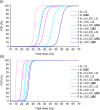Treatment fractionation for stereotactic radiotherapy of lung tumours: a modelling study of the influence of chronic and acute hypoxia on tumour control probability
- PMID: 24974778
- PMCID: PMC4091751
- DOI: 10.1186/1748-717X-9-149
Treatment fractionation for stereotactic radiotherapy of lung tumours: a modelling study of the influence of chronic and acute hypoxia on tumour control probability
Abstract
Background: Stereotactic body radiotherapy (SBRT) for non-small-cell lung cancer (NSCLC) has led to promising local control and overall survival for fractionation schemes with increasingly high fractional doses. A point has however been reached where the number of fractions used might be too low to allow efficient local inter-fraction reoxygenation of the hypoxic cells residing in the tumour. It was therefore the purpose of this study to investigate the impact of hypoxia and extreme hypofractionation on the tumour control probability (TCP) from SBRT.
Methods: A three-dimensional model of tumour oxygenation able to simulate oxygenation changes on the microscale was used. The TCP was determined for clinically relevant SBRT fractionation schedules of 1, 3 and 5 fractions assuming either static tumour oxygenation or that the oxygenation changes locally between fractions due to fast reoxygenation of acute hypoxia without an overall reduction in chronic hypoxia.
Results: For the schedules applying three or five fractions the doses required to achieve satisfying levels of TCP were considerably lower when local oxygenation changes were assumed compared to the case of static oxygenation; a decrease in D50 of 17.7 Gy was observed for a five-fractions schedule applied to a 20% hypoxic tumour when fast reoxygenation was modelled. Assuming local oxygenation changes, the total doses required for a tumor control probability of 50% were of similar size for one, three and five fractions.
Conclusions: Although attractive from a practical point of view, extreme hypofractionation using just one single fraction may result in impaired local control of hypoxic tumours, as it eliminates the possibility for any kind of reoxygenation.
Figures



Similar articles
-
Optimal fractionation in radiotherapy for non-small cell lung cancer--a modelling approach.Acta Oncol. 2015;54(9):1592-8. doi: 10.3109/0284186X.2015.1061207. Epub 2015 Jul 28. Acta Oncol. 2015. PMID: 26217986
-
Hypoxia Induced by Vascular Damage at High Doses Could Compromise the Outcome of Radiotherapy.Anticancer Res. 2019 May;39(5):2337-2340. doi: 10.21873/anticanres.13350. Anticancer Res. 2019. PMID: 31092425
-
Computed 88% TCP dose for SBRT of NSCLC from tumour hypoxia modelling.Phys Med Biol. 2013 Jul 7;58(13):4611-20. doi: 10.1088/0031-9155/58/13/4611. Epub 2013 Jun 14. Phys Med Biol. 2013. PMID: 23771131
-
Altered fractionation schemes in radiotherapy.Front Radiat Ther Oncol. 2010;42:150-156. doi: 10.1159/000262470. Epub 2009 Nov 24. Front Radiat Ther Oncol. 2010. PMID: 19955801 Review.
-
[Stereotactic radiotherapy for non-small cell lung cancer: From concept to clinical reality. 2011 update].Cancer Radiother. 2011 Oct;15(6-7):522-6. doi: 10.1016/j.canrad.2011.07.241. Epub 2011 Sep 1. Cancer Radiother. 2011. PMID: 21889901 Review. French.
Cited by
-
Radiobiological modeling of two stereotactic body radiotherapy schedules in patients with stage I peripheral non-small cell lung cancer.Oncotarget. 2016 Jun 28;7(26):40746-40755. doi: 10.18632/oncotarget.9442. Oncotarget. 2016. PMID: 27203739 Free PMC article.
-
Radiation-induced Vascular Damage and the Impact on the Treatment Outcome of Stereotactic Body Radiotherapy.Anticancer Res. 2019 Jun;39(6):2721-2727. doi: 10.21873/anticanres.13398. Anticancer Res. 2019. PMID: 31177107 Free PMC article.
-
The Impact of Radiation on the Tumor Microenvironment: Effect of Dose and Fractionation Schedules.Cancer Growth Metastasis. 2018 Mar 9;11:1179064418761639. doi: 10.1177/1179064418761639. eCollection 2018. Cancer Growth Metastasis. 2018. PMID: 29551910 Free PMC article. Review.
-
Radiobiological Optimization in Lung Stereotactic Body Radiation Therapy: Are We Ready to Apply Radiobiological Models?Front Oncol. 2018 Jan 8;7:321. doi: 10.3389/fonc.2017.00321. eCollection 2017. Front Oncol. 2018. PMID: 29359121 Free PMC article. Review.
-
Current Evidence for Stereotactic Body Radiotherapy in Lung Metastases.Curr Oncol. 2021 Jul 15;28(4):2560-2578. doi: 10.3390/curroncol28040233. Curr Oncol. 2021. PMID: 34287274 Free PMC article. Review.
References
-
- Fritz P, Kraus HJ, Blaschke T, Mühlnickel W, Strauch K, Engel-Riedel W, Chemaissani A, Stoelben E. Stereotactic, high single-dose irradiation of stage I non-small cell lung cancer (NSCLC) using four-dimensional CT scans for treatment planning. Lung Cancer. 2008;60:193–199. doi: 10.1016/j.lungcan.2007.10.005. - DOI - PubMed
Publication types
MeSH terms
Substances
LinkOut - more resources
Full Text Sources
Other Literature Sources
Medical

